
From its fruit-forward flavor to its soft and elegant body, Merlot wine has impressed connoisseurs for centuries. Because of its diverse range of styles, Merlot shines as both a blending wine and a single variant. The comparatively lower tannin presence of Merlot makes it a smooth and accessible addition to any collection, as well as a perfect option for those just beginning to drink red wines. Merlot is an easy-to-drink red wine that can complement a wide array of dishes.
Despite its merit as a versatile and classic wine, consumers recently moved away from Merlot due to plummeting quality in the 1990s and poor pop culture representation. However, devoted vintners continued to cultivate stellar products despite the market setback, and Merlot slowly regained its rightful place among classic red wines. Merlot is now the second most-planted grape in the world, covering roughly 600,000 acres across the globe in 2010. Found in vineyards from California to France to Italy to Australia, Merlot is definitely a grape you shouldn’t ignore.
What Is Merlot Wine Like?
If you’ve never taken French, your first question may be, “How do you pronounce Merlot wine?” Pronounced “mur-loh” or “mair-loh,” Merlot grapes are related to the French grapes cabernet franc and a more obscure vine, the Magdeleine Noire des Charentes. The Merlot grape has a deep black-blue color and a thin, delicate skin. Its name derives from a word meaning “little blackbird” in an older dialect related to French, though it is uncertain whether this refers to the color of the fruit or the birds’ fondness for the grape.
Because they can grow in a variety of soils and climates, Merlot grapes grow in most wine-producing countries. Most Merlot grapes grow in France, but the United States has also become a significant presence in the Merlot world, cultivating around 55,000 acres. Merlot is the fifth most-planted wine grape in Italy, and it also grows in parts of Chile, Australia, New Zealand, Spain, South Africa, Argentina, Switzerland, Bulgaria and China.
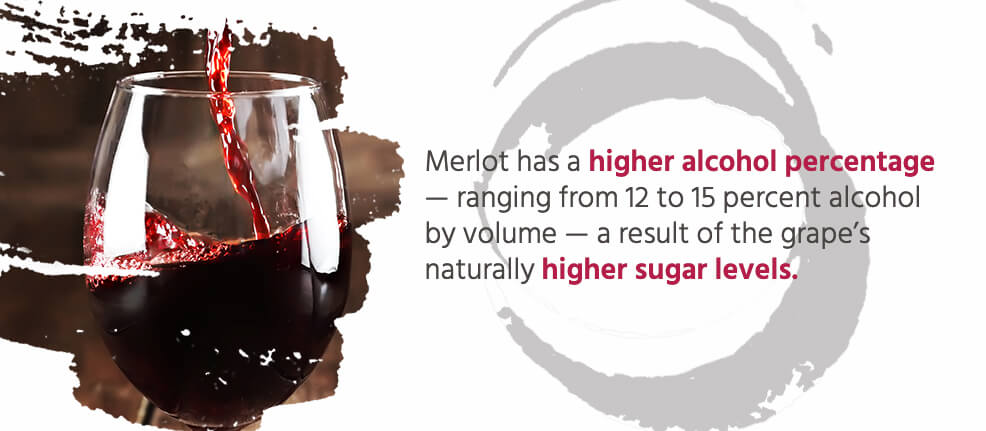
What kind of wine is Merlot? With a velvet-red color and medium-to-full body, this fruity wine falls between pinot noir and Syrah wines in fullness and hue. Merlot has a higher alcohol percentage — ranging from 12 to 15 percent alcohol by volume — a result of the grape’s naturally higher sugar levels, which lead to a higher alcohol content at the end of the winemaking process. While Merlot is a dry wine, it is sweeter than other reds like cabernet sauvignon.
Because of Merlot’s milder flavor and lower tannin levels, winemakers often use it in blends to soften stronger red wines, especially cabernet sauvignon. How long can you keep Merlot wine? While vineyards sometimes age Merlot in oak to increase its richness or complexity during the winemaking process, you should keep most bottles of Merlot for only three to five years after purchase.
Merlot, a History
Originating in the hills of the Right Bank of Bordeaux, Merlot entered the wine scene in the late 1700s. It first earned praise as a blending wine to add softness and lushness to the favorite grape of the region, cabernet sauvignon. This match led to the world-renowned Bordeaux blend, which has delighted wine enthusiasts for centuries. Merlot gained popularity as a powerful blending wine and began to spread across the world. Although it thrives in the clay and limestone soil of France, part of Merlot’s success is its adaptability, which enables it to flourish in regions across the globe. Merlot is especially successful in Italy, where the grape is behind the best of the “super-Tuscan” wines.
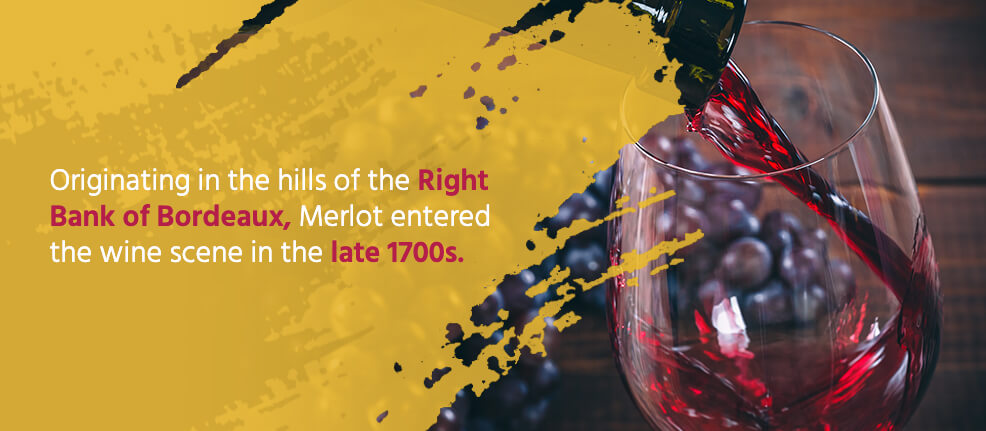
Despite Merlot’s popularity in its home region, winemakers did not produce it as a single variant until the grape traveled outside France. Vintners in California began developing 100 percent Merlot varieties, due to Americans’ love of the lightness and lower tannin levels of the wine. While this led to a boom in Merlot’s production and popularity, it also led to the brief decline of Merlot in the 20th century.
The Rise, Fall — Then Rise Again — of Merlot
Merlot arrived in California in the mid-19th century, but remained relatively obscure until the 1990s. As the winemaking industry in California grew, vintners recognized Merlot as an easy grape to produce in large quantities. Its ability to mass produce, coupled with its milder flavor, caused Merlot to skyrocket to fame. Merlot enjoyed two decades of incredible market success. However, because of its fast rise, many producers were growing the grapes in subpar conditions and over-irrigating the vines to keep up with market demands. Rushed production led to cheap, low-quality wine that began to tarnish the once-loved wine’s reputation.
But in 2004, Merlot had its downfall. The critically acclaimed film “Sideways” premiered, featuring a protagonist who was less than complimentary about the wine. Pinot noir became the sleek, sophisticated wine of choice, leaving Merlot in its dust.
The combination of poor production and bad reputation had one positive, however — the winemakers who continued to grow Merlot re-committed to producing the highest quality. This revival did not go unnoticed, and popular opinion about Merlot began to turn. More and more people are rediscovering the beauty of this versatile wine, and a thinner market means you can now find good-quality Merlot at lower prices. Merlot even has its own holiday, International Merlot Day, which you can celebrate on November 7 with a bottle of your new favorite red wine.
How Is Merlot Made?
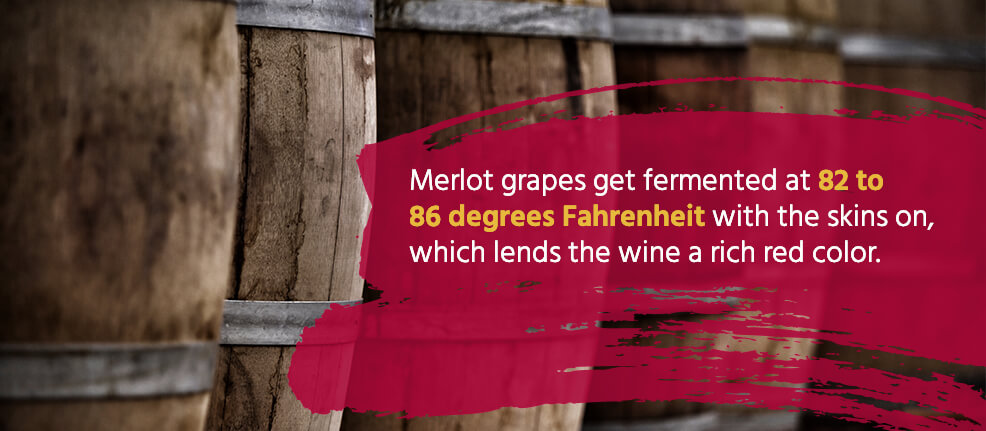
To begin the winemaking process for merlot, vintners take care to remove all stems from the grapes to decrease the tannin level and bitterness of the wine. Merlot grapes get fermented at 82 to 86 degrees Fahrenheit with the skins on, which lends the wine a rich red color. Because they have thinner skin than other red wine grapes, Merlot wine naturally has a lower tannin level. Tannins are chemicals predominantly in the skins, seeds and stems of grapes, as well as the wood where the wine ages. Although they do not carry any smell or taste, tannins give wine structure and texture by introducing astringency, which is the sensation of dry mouth that causes your facial muscles to tighten when you take a sip. Tannin levels in wine are distinct from acidity — while we experience tannins through touch or texture, we experience acidity as a flavor.
During the fermentation, many producers will push down on the skins three times a day to keep them wet. Time spent in skins varies between vintners, but an average is 14 to 21 days. For a softer finish, producers keep the wine for fewer days on the skins.
Following the fermentation process, winemakers store Merlot inside oak barrels at a temperature of 26 degrees Fahrenheit, or a little below, and typically age it for about eight months to a year. Aging Merlot in oak adds more tannins to the wine.
Like with any wine, vintners can make variations during the process to change the flavor profile of a Merlot. The degree of aeration, force of press, time of harvest and temperature all contribute to the unique character of each Merlot variety.
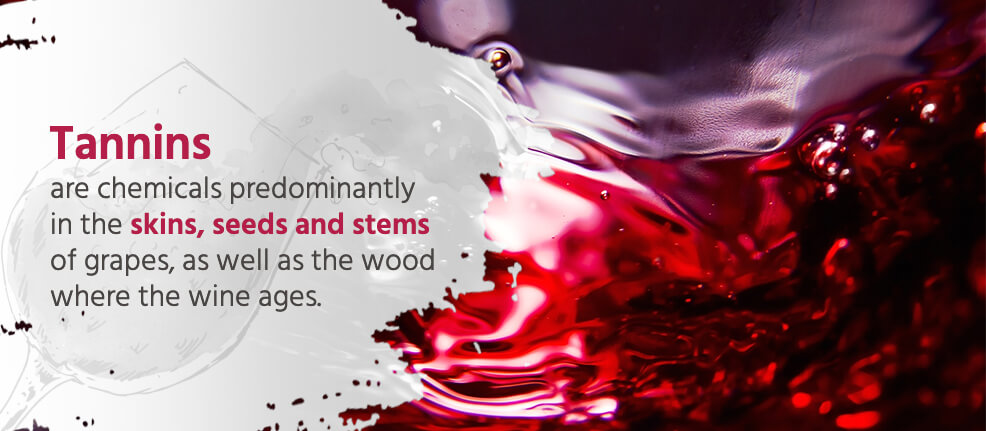
It’s All About the Fruit — Merlot’s Taste Profile
What does Merlot wine taste like? While it is a dry wine, Merlot is comparatively low in tannins. That creates a smoother, less bitter experience, and makes Merlot softer and easier to consume than many of its counterparts. The most notable flavor and aroma of Merlot wine is fruit. Often, Merlot carries raspberry notes, as well as black cherry, plum, blueberries and even jam. These notes give many Merlots an aroma similar to fruitcake. Other common notes of Merlot include graphite, cedar, tobacco, vanilla, cloves and chocolate.
However, depending on the climate where the grapes grow, Merlot wines can have a diverse array of flavors. Merlot grapes fall into two different growing climates — cool and hot. In the world of wine, these terms are more subjective. Old World producers consider 60 degrees Fahrenheit to be “warm,” but the same temperature is “cool” for many New World vineyards. Below are some general differences between Merlot grown in cool and warm climates.
1. Cool-Climate Merlot
Cool-climate varieties are the classic Merlot. From the hills of France, Italy and Chile, these strains feature heavy, earthy flavors like tobacco and tar. Because of their higher concentration of tannins, it’s easy to confuse these Merlots with cabernet sauvignon, their regional counterpart.
Cool-climate Merlots contribute to the famed Right Bank Bordeaux blends, along with vintage strains such as St. Emilion, Pomerol and Fronsac.
2. Warm-Climate Merlot
Warm-climate Merlots heavily feature fruit notes and a lighter body. Grown in the sun-filled valleys of California, Australia and Argentina, these wines have a lower tannin presence and a softer finish. Classic warm-climate Merlots come from California’s Paso Robles and Napa Valley.
For warm-climate Merlots, vintners sometimes prefer an oak-aging process of up to 24 months, which gives the delicate wine more structure.
Types of Merlot Around the Globe
Every province where Merlot grapes thrive produces slightly different characteristics in the wine. Below are the top-producing Merlot regions, and descriptions of what makes them unique.
1. Bordeaux
The birthplace of the grape, Bordeaux, France, is home of the most iconic Merlots. Merlot remains the most commonly planted grape along the river, especially on the Right Bank. Bordeaux Merlots have prominent earth and mineral tones, depending on the soil they grow in. Bordeaux vineyards with limestone-rich soil tend to produce Merlots with fresh mineral notes, while clay soil produces broader, more robust flavors. Bordeaux Merlots can be unoaked or stored in new French oak. Many of the region’s grapes go into value-driven blended wines. However, some, such as Château Pétrus, develop over decades.
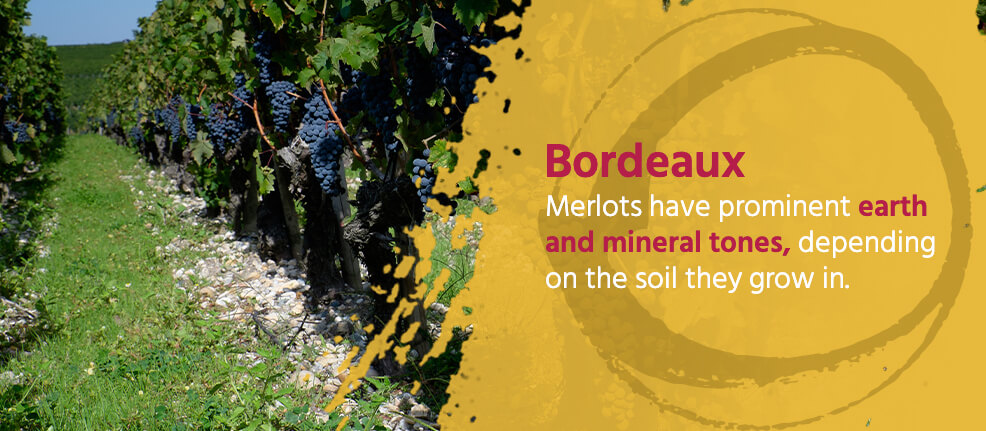
For a Bordeaux Merlot blend, try the Chateau Saint-Sulpice Bordeaux. Made with 70 percent Merlot, 20 percent cabernet sauvignon and 10 percent cabernet Franc, this wine features black cherry, spice and plum notes, and is best after airing for about an hour.
2. Tuscany
Under the warm sun of central Italy, Merlot grapes from Tuscany tend to be slightly larger, which some vintners say lessens harsh tannins. Tuscany Merlots are famous and expensive, and can feature the Merlot grape on its own or blended with Bordeaux or local varieties. The Merlot grapes that grow in Tuscany often contribute to blends known as the “super-Tuscans,” such as Toscana IGT or Bolgheri DOC. Tuscany Merlots range from oak-forward, broad profiles to earthy, subtle flavors.
3. Friuli-Venezia Giulia
In the northeastern part of Italy, Friuli-Venezia Giulia is most famous for its indigenous white grapes, but Merlot is the most-planted red grape in the region. Like their central Italian cousins, these Merlot grapes can be blended or grown as a single varietal. Some small wineries produce expensive cool-climate Merlots, which burst with anise, spice and stone notes.
4. California
Merlot grapes are the second-most popular grape in this sunny state known for its vineyards. California Merlots range from sweet grocery store varieties to high-end, nuanced masterpieces. As the best-known wine regions in the state, Paso Robles and Napa Valley produce delectable Merlots characterized by a smooth, jammy fruit profile, along with hints of vanilla, sweet spice and new oak.
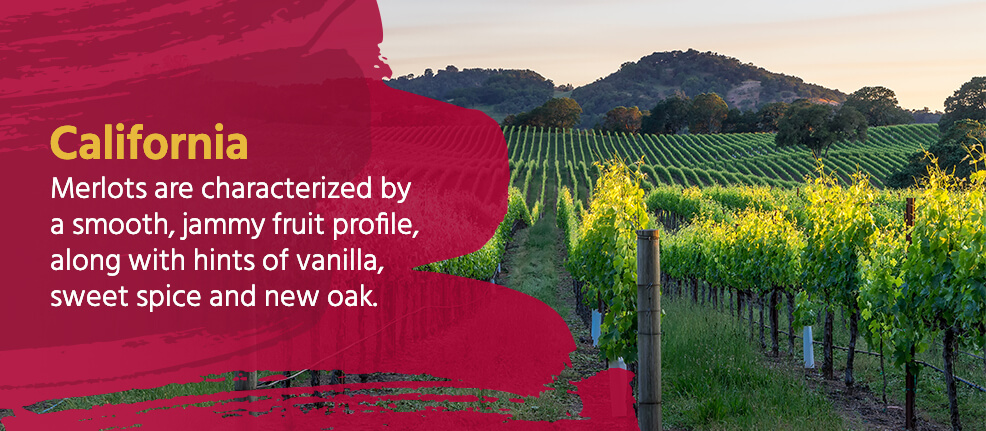
If you are interested in a classic California Merlot, try the consumer-favorite Marilyn Merlot, which offers flavors of blueberries and vanilla.
5. Washington
Washington’s interest in Merlot sparked around the same time as California’s, but the Evergreen State kept at it after the Golden State turned away. Producers combined the versatility of Merlot with their signature tradition of medium-bodied wines. Washington vintners blend the best of the New World and the Old, giving their Merlots lush flavors of cherry and other berries. Washington Merlots tend to feature greater acidity and tannic bite. The Columbia Valley produces the highest quantity of Merlots, but other regions producing excellent Merlots include Horse Heaven Hills, Walla Walla Valley and Red Mountain.
Consider the Columbia Crest Grand Estates Merlot as a starting point. This aromatic wine has smooth notes of coffee, plum and dark chocolate.
6. Chile
Historically, Chilean reds have been cabernet sauvignon or carménère-based wines, but Merlot is quickly gaining ground in this coastal South American country. For a few decades during the late 20th century, Chilean vineyards sold and marketed wine with incorrectly identified carménère grapes as Merlot. Producers have since caught the mistake and imported genuine Merlot cuttings, and vineyards have been thriving ever since. Chilean Merlots are typically powerful and fruit-driven. High-end, excellent quality Merlots come from the Apalta region of Colchagua Valley. These wines are comparable to the fruity, bold California varieties.
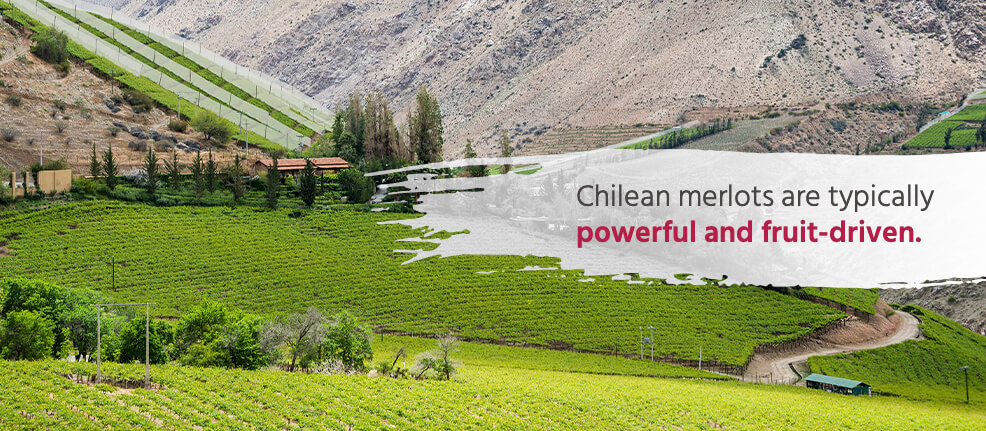
7. Australia
The first Merlot-growing vineyards in Australia didn’t register until the 1980s, so the country is still a new producer. However, the production of Merlot has expanded enormously in the past 30 years, and Australian vineyards are now impossible to ignore. Australian producers are still determining the best regions for growing Merlot grapes, but dependable regions include McLaren Vale, Barossa Valley, Coonawarra and along the Margaret River. It’s easy to identify Australian variants by their powerful fruit overtones and woody flavors.
Begin with an Oxford Landing Merlot for a bouquet of blueberry, plum and red currants, along with slight cedar, oak and spice undertones. Look for soft tannins and a rich finish in this lovely Merlot.
How to Serve Merlot Wine
Because of their lower acidity and pleasant fruity sweetness, Merlots pair excellently with many foods. Unlike heavier red wines that often pair best with red meat, Merlot can be an excellent choice for poultry and pasta dishes. However, different Merlots pair better with different foods, so we’ve grouped our Merlot pairing recommendations into three broad categories: light-bodied, medium-bodied and heavier-bodied blends.
- Light-bodied Merlots go excellently with toasted cheese dishes, such as white and red pizzas, paninis and quesadillas. Softer Merlots are a great complement to pasta and other meals featuring tomato sauce, especially when combined with earthy flavors like mushrooms. A light Merlot can be the perfect red wine to drink in the summer with light meals such as grilled chicken or grilled vegetables like zucchini, peppers and eggplant. Light-bodied Merlots also pair well with charcuterie spreads.
- Medium-bodied Merlots go well with slightly heavier meats such as Italian-style sausages and meatballs. Baked pasta dishes and vegetables are a dependable pairing, along with meatloaf and casseroles. Cheeseburgers are also a perfect match with a medium Merlot. Medium Merlots can also go well with spicier foods like jambalaya and bean dishes. Consider pairing a medium Merlot with seared salmon or dishes with fruit flavors. As long as it does not have too sharp of a flavor, a mild-to-medium hard cheese can go well with a glass of medium-bodied merlot.
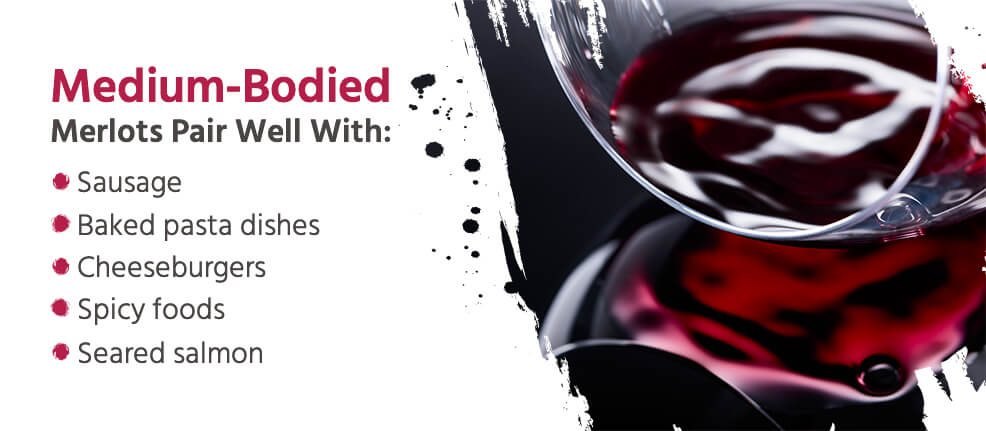
- Heavy-bodied or classic Merlots go well with most roasted meats, including lamb or pork. Grilled pork chops prepared with thyme or rosemary can be a lovely partner for a heavy-bodied Merlot. When pairing classic Merlots with meats, make sure to lightly spice the meats, so as not to overwhelm the wine. If opting for a heavier dish or more strongly spiced meal, a Merlot-dominated blend may be the best choice.
Red Wine Cocktails
While Merlot is delicious on its own, mixing it into wine cocktails can help give it a new twist – and is especially good if you have value priced bottles on hand.
1. San Francisco Sangaree
For a classic, warm-weather sangaree, try this recipe with your favorite Merlot.
- 4 fresh cherries
- ¼ ounce of simple syrup
- 1 ½ ounces of Merlot
- 1 ounce of bourbon
- 1 lemon slice
- If you do not have simple syrup on hand or prefer to make your own from scratch, just combine equal parts hot water and sugar. Stir until all the sugar is dissolved and allow the syrup to cool.
- Placecherriesin a cocktail shaker and gently muddle to break the skins.
- Fill the cocktail shaker with ice,then add your simple syrup, Merlot and bourbon.
- Shakewell and then strain into a glass filled with ice. Serve with a lemon slice.
2. Nouveau Sangaree
This apple-brandy-and-gin sangaree is decidedly American and perfect for a cool autumn evening.
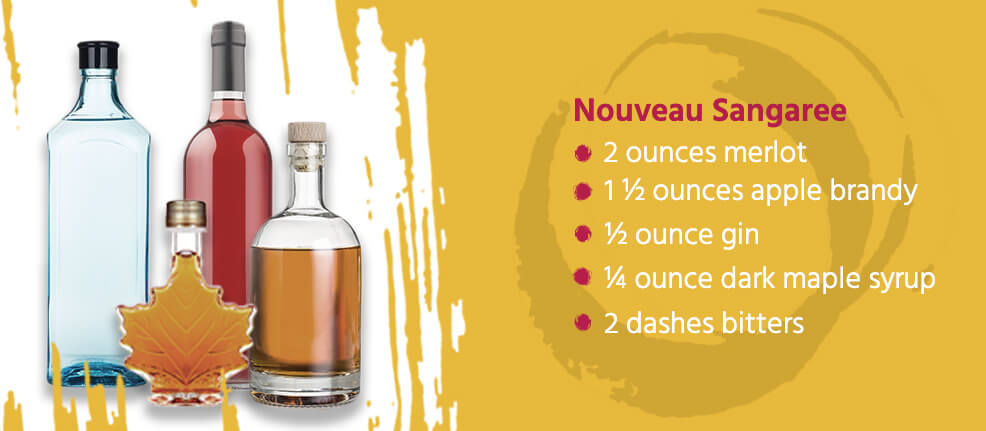
- 2 ounces of Merlot
- 1 ½ ounces of apple brandy
- ½ ounce of gin
- ¼ ounce of dark maple syrup
- 2 dashes of bitters
- Add all ingredients to a mixing glass and fill with ice.
- Stir untilchilled and well-blended, and then strain into a chilled cocktail glass.
- Garnish with thin apple slices and grated cinnamon.
Find the Perfect Merlot Online
With its softer flavor and fruit-filled profile, Merlot is perfect for red wine enthusiasts and new wine drinkers alike. Curious about the diverse world of Merlot? At Marketview Liquor, we pride ourselves on our wide selection of affordable, high-quality wines. From earthy, cool-climate Bordeaux blends to fruity Napa Valley classics, we have a Merlot for every occasion and to pair with any meal.
Sample Merlots from around the world with our case discount on select merlot wines. Take the stress out of buying wine online — begin your Merlot experience by browsing our selection.
